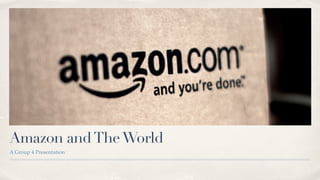Strat
- 1. Amazon andTheWorld A Group 4 Presentation
- 2. Background âĪ Amazon.com, Inc. is an American electronic commerce company with headquarters in Seattle, Washington. âĪ Delivering products since 1994. âĪ Started with e-retailing books. Grew exponentially. âĪ Amazon also sells certain low end products like USB cables under its in-house brand Amazon Basics. âĪ The company also produces consumer electronicsânotably, Amazon Kindle e-book readers, Fire tablets, Fire TV and Fire Phone â and is a major provider of cloud computing services.
- 3. âOur vision is to be Earth's most customer centric company; to build a place where people can come to ïŽnd and discover anything they might want to buy online.â Amazonâs Mission/Vision
- 4. 01 ! Mission orVision? âĪ Mission Vs. Vision âĪ Strategic Management Insight score 1.7? âĪ The focus on Customers. âĪ DiversiïŽcation into all commodities that can be sold online. âOur vision is to be Earth's most customer centric company; to build a place where people can come to ïŽnd and discover anything they might want to buy online.â
- 5. Amazonâs Venture Into India Strategy 1
- 6. 01 What?When?Where? âĪ Amazon.com entered the Indian e- commerce space with its online marketplace Amazon.in. âĪ Junglee.com tested waters. âĪ June 5, 2013 âĪ Initial cities targeted- Bangalore, Hyderabad & Chennai.
- 7. Why? âĪ Indian e-commerce market expected to grow to $200 billion by 2020. âĪ India a vital market for global dominance in e-commerce. âĪ Indian market far from saturation. Internet penetration is a mere 20%.
- 8. How? How much? âĪ Cap of 49% for FDI in B2C online markets. âĪ Use of marketplace model to work around the FDI limit. âĪ Catalogue size: 7 million books and 12000 movies, through 100 sellers. âĪ Investment amount not disclosed.
- 9. Amazon Indiaâs performance and strategic moves âĪ Amazon now has a base of 5000 sellers. âĪ Selection of 15 million products across 25 categories. âĪ First among its competition to introduce same-day and next-day deliveries.
- 10. 01 Competitor Comparison âĪ Intense competition has led to aggressive pricing and discounts being paid by venture capitalists. âĪ Money is being burned to acquire new customers. âĪ Flipkart leads in Net Revenue. âĪ However Flipkart leads in losses as well, by a greater margin. !
- 11. Was the strategy successful? âĪ Amazon.in became the second largest e-retailer a year from launch. âĪ Hard work ahead to catch up with local giants. âĪ Timing of the entry had certain advantages - 1. Groundwork already done by homegrown competitors. 2. An exhausted competition.
- 12. Did a competitor execute a similar strategy? âĪ eBay entered India in 2004 by buying out baazee.com. âĪ In 2005 renamed it eBay.in. âĪ One of the earliest online marketplaces in the country. âĪ It has slipped behind both Flipkart & Amazon.
- 13. Conclusion
- 15. 01 Unique Features âĪ Exclusively on AT&T âĪ $199.99 on contract âĪ High quality speakers âĪ Cloud Storage âĪ Mayday-24 hour live support âĪ Dynamic 3D perspective âĪ FireïŽy
- 16. WHY DIDTHEY DO IT? âĪ To revolutionise Brick & Mortar and e-Commerce shopping. âĪ To understand consumer behaviour in depth. âĪ CAGR in the cellphone market - 12.3%.
- 17. LETâS DO SOME NUMBER CRUNCHING
- 18. Amazon sold a total of 35,000 ïŽre phones till August 2014. Value of unsold phones - $83 million. Losses on Fire Phone- $170 million.
- 19. Smartphone market share in 2014
- 21. 01 WHY DIDTHEY FAIL? âĪ It doesnât do anything you canât already do with a stock Android device. âĪ Restricted application usage. âĪ It is quite expensive. âĪ It has 3D but without a 3D screen âĪ It takes away the consumersâ power to choose. âĪ Only sold on AT&T.
- 22. 01 WHAT COULD HAVE BEEN DONE BETTER? âĪ Offer it on multiple carriers. âĪ Get better services. âĪ Be more creative with the pricing.
- 23. 01 HOW DID MICROSOFT DO IT? âĪ Used forward integration to acquire Nokia. âĪ Nokia already used Windows OS for 80% of its devices. âĪ Nokia brought ïŽnancial capabilities to Microsoft.
- 24. SWOT Strength Brand well known along with a strong customer base. Diverse product offerings Strong business relationships with publishing houses, major electronic companies etc. Experience of almost two decade. Weakness Operates at very low margin âKINDLEâ is not up to the mark to its competitors Brand dissonance with Junglee and Amazon Opportunity Acquiring more small business enterprises. Opening physical stores so as to give the customers a feel of touch and experience. Indian retail industry is estimated to be $450 Billion. Threats Online security threats Regional low-cost retailers Strong online presence of Indian competitors like Flipkart and Myntra Flexible rules against FDI enabling other major players like Wal-Mart etc. to enter
- 25. Any Questions?
























